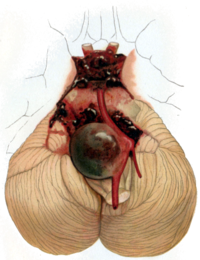
Photo from wikipedia
BACKGROUND & AIMS Obesity surgery induces beneficial effects in metabolic and cardiovascular parameters. Adiponectin increase might be associated with some of these changes. However, direct comparison between different surgical techniques… Click to show full abstract
BACKGROUND & AIMS Obesity surgery induces beneficial effects in metabolic and cardiovascular parameters. Adiponectin increase might be associated with some of these changes. However, direct comparison between different surgical techniques has not been extensively performed. METHODS We studied 20 obese women submitted to laparoscopic Roux en Y gastric bypass (RYGB) and 20 to sleeve gastrectomy (SG). Twenty control women matched for age and baseline metabolic profiles were also included. Both patients and controls were followed up for one year after surgery or conventional treatment with diet and exercise, respectively. Serum adiponectin was measured at baseline, 6 months and 1 year after, as well as lipid profiles, sex hormone binding globulin (SHBG), fasting glucose and insulin. Carotid intima-media thickness was measured by ultrasonography at baseline and after 1 year. RESULTS Circulating adiponectin increased after obesity surgery (more markedly following RYGB than after SG), whereas no changes were observed in the controls (Wilks' λ = 0.659, P < 0.001 for the interaction, P < 0.001 for RYGB vs. controls, P = 0.016 for SG vs. controls, P = 0.040 for RYGB vs. SG). The percentage increment in adiponectin correlated positively with changes in SHBG (r = 0.404, P = 0.002) and negatively with changes in weight (r = -0.531, P < 0.001), waist circumference (r = -0.426, P = 0.001), fasting glucose (r = -0.356, P = 0.006), and insulin (r = -0.496, P < 0.001). No correlation was found with carotid intima-media thickness (r = -0.055, P = 0.679). CONCLUSIONS RYGB induces a higher increase in adiponectin than SG, which parallels SHBG, the reduction of fasting insulin and insulin resistance. On the other hand, no association was found with carotid intima-media, lipid profiles or blood pressure.
Journal Title: Clinical nutrition
Year Published: 2018
Link to full text (if available)
Share on Social Media: Sign Up to like & get
recommendations!